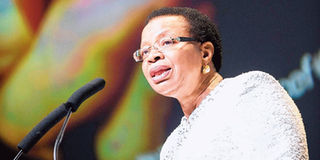Tanzania tumbles in child deaths battle

Graca Machel, widow of late South African president and global icon Nelson Mandela, speaks at a conference on improving maternal, newborn and child health, at the Sandton Convention Centre, in Johannesburg yesterday. Graca Machel, on June 27 announced she will resume her public life after completig a six-month mourning period for the “best friend”. PHOTO | AFP
What you need to know:
“The plan has the potential to spur progress towards the wider ambition –proposed for the post-Millennium Development Goal framework—of ending all preventable deaths of children aged under five by 2030,” reads the report in part.
Johannesburg. Tanzania’s hope to achieve the Millennium Development Goal (MDG) Four on the reduction of child deaths now faces a daunting task with new reports showing the country is retreating.
Unicef’s State of the World’s Children 2014 Report, shows that Tanzania has seen a 68-percent reduction in child mortality rate since 1990, falling from 166 per 1,000 births in 1990 to only 54 in 2012.
But the Countdown to 2015 report released here yesterday at the Partnership for Maternal, Newborn and Child Health (PMNCH) forum shows that Tanzania has relaxed while other countries have tightened the fight.
The report highlights trends in child mortality in the 75 Countdown countries, Tanzania included, by average annual rate of reduction which shows that from 2000 to 2012, Tanzania did well and it was ranked in the fifth place after having reduced under-five mortality at an annual rate of 7.4 per cent.
Rwanda stands tall on top of the list with 10 per cent followed by Cambodia (8.5 per cent), China (8.1 per cent), and Malawi (7.5 per cent) while at the end stand Burundi and Ghana both of which scored three per cent, Sudan (3.1 per cent), Turkmenistan (3.3 per cent) and Myanmar (3.4 per cent).
But Tanzania’s average annual rate of reduction from 2000 to 2013 was poor, seeing the country nosedive from the fifth position to 16th with a receding rate of 4.8 per cent.
As the country is overtaken by the likes of Lao People’s Democratic Republic, Equatorial Guinea and Afghanistan which are ranked third, fourth and fifth respectively, previous front runners Rwanda and Cambodia worked even harder and maintained the lead in the same positions with increased rates of 8.6 per cent and 8.4 per cent respectively.
Another report launched yesterday, ‘Every Newborn Action Plan’, with the theme ‘A Common Threat: Reaching Every Woman and Every Newborn’ puts Tanzania amongst the top 10 countries with the highest number of newborn deaths and stillbirth as of 2012, despite the achievements it had recorded by that date.
With a total number of 86,800 newborn deaths and stillbirths, Tanzania is number nine on the list and contributes two per cent to the global burden.
The action plan comes after the 67th World Health Assembly which sat in May this year where governments committed to end preventable deaths. The plan estimates that achieving high coverage of care by 2025 would prevent nearly three million deaths of women and newborn babies and stillbirths (1.9 million newborns, 0.2 million mothers 0.8 million stillbirths). The numbers comprise 87 per cent of preventable maternal and newborn deaths.
“The plan has the potential to spur progress towards the wider ambition –proposed for the post-Millennium Development Goal framework—of ending all preventable deaths of children aged under five by 2030,” reads the report in part.
Releasing the countdown report, themed ‘Fulfilling the Health Agenda for Women and Children’, the forum noted that although many developing countries have taken substantive action to save women and children’s lives, vast areas of ‘unfinished business’ still need to be addressed.
According to the report, the 75 countries covered in the countdown account for more than 95 per cent of all maternal and child deaths each year, adding that virtually in every countdown country, the wealthy receive far higher coverage of key interventions than the poor.
“Now is the time to make a final push on the health Millennium Development Goals Four and Five and to set the stage for the elimination of preventable maternal and child deaths in the years beyond 2015,” said Dr Zulfiqar Bhutta of the Hospital for Sick Children in Toronto, Canada and Aga Khan University in Pakistan who is of Countdown to 2015, adding:
“To achieve these goals, we need to do a much better job of reaching the poor, young people, indigenous groups and other vulnerable people with essential health services.”
According to the ministry of Health and Social Welfare, the government is banking on a strategic plan for accelerating the reduction of maternal and childhood deaths (2008-2015) to soldier on.
Deputy minister for Health, Dr Stephen Kebwe, who is attending the forum said some 2,439 heath workers have been trained on life saving skills for delivery care and 622 community health workers have been trained on community sensitisation pertaining to the importance of health facility, delivery, maternal care up to 40 days after delivery and home-based care.
The ministry is also implementing a project to support maternal mortality in collaboration with the African Development Bank (AfDB) in Mtwara, Mara and Tabora regions where maternal mortality rates are stubbornly high, he said.
Construction and rehabilitation of some health facilities in these regions have been made and equipment installed, he added. “To ensure there is steady reduction of deaths, 1,412 heath providers on integrated management of childhood illnesses from 11 regions and 7,361 service providers have been trained on neonatal resuscitation,” he said.




